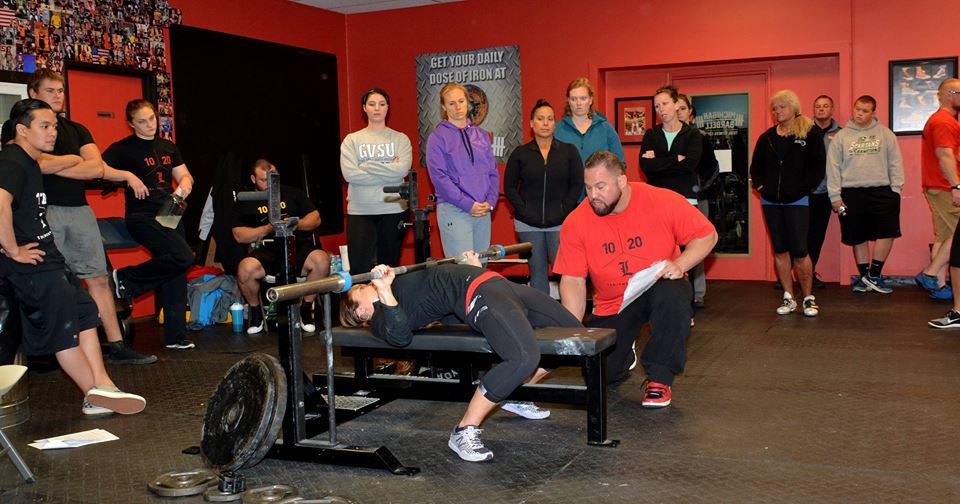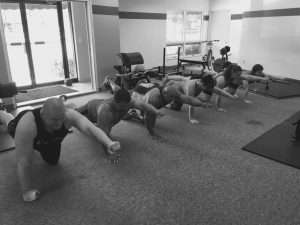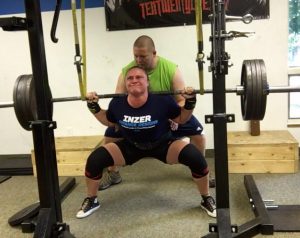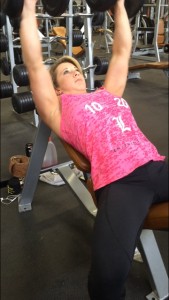
11 Sep 53 Things I learned at the SECOND 10/20/life Seminar With Brian Carroll & Jonathan Byrd
By: Admin/Friends of PRS-Driven Fitness Center
Brian Carroll and Jonathan Byrd recently put on a second seminar at Driven Fitness Center in Salina, KS.
“I’m going to be honest, I kinda thought all I would get out of this years seminar was some brush up on technique. I picked up a few other things too.”–Trey Potter, co-owner Driven Fitness Center.
Check out Trey Potter’s list of some of the valuable information taught at a 10/20/life seminar.
10/20/LIFE Takeaways
#1 – Periodization of your social life. Make frequent deposits during “offseason” times to basically bank social credit for the times where you’re not going to be able to make many social events during meet prep.
#2 – Be an athlete 24 hours a day, 7 days/week. Going to the gym a couple days each week isn’t enough to undo all the damage they’re doing from poor posture and movement the 160+ hours that you’re not in the gym. Treat every movement just like you would a max effort lift.
#3 – Warm up like a boss. (A) General movement (B) McGill 3 (C) Movement Specific (D) Bar
#4 – Meet prep isn’t a time to be dieting or attempting to gain muscle. It’s a time for refinement of technique, getting accustomed to your gear, and peaking your nervous system so you can put 100% into meet day instead of missing lifts due to overtraining. It’s a time to TEST your strength, not build it.
#5 – Meet prep is also the time to dial in your nutrition, recovery, and training to maximize your potential. No missed or half-assed training. Training NEEDS to be a high priority.
#6 – Offseason is where strength is built and weaknesses are brought up. It’s also the time to be more flexible in your training approach. When in doubt, make the best of less than optimal situations and move on. This is where you’d schedule trips and vacations, not during meet prep.
#7 – The RPE is relative to how you’re feeling and the equipment available. Go by feel and stay conservative. Save the hard set numbers for meet prep.
#8 – Strength is built in the 6-8 RPE range. Anything above that is just testing. Always have reps in the tank during the offseason.
#9 – If you need to drop body fat for your health or whatever reason, the offseason is the perfect time since you’re not shooting for specific numbers and training intensity is relative to how you’re feeling.
#10 – Don’t take unnecessary risks in training or competition. Career ending injuries are never the goal so weigh your actions versus outcomes. Going for a new squat PR in training might sound good because everything is moving well, but there is the risk of major injury. Same with competition. It may be necessary for you not finish or just take a token lift to get a total so that you can come back and fight again another day.
#11 – Surround yourself with a good team who support each other. You need this to hold you accountable, improve technique, and to help you out on meet day. Just because certain numbers or a course of action sound good to you doesn’t mean it is. A good teammate will rein you back in when shits spiraling out of control. Also, good spotters can save your life and your lifting career.
#12 – Take every rep with 100% focus and intensity. Sure, lots of injuries happen with max weights. Even more happen with warm up weights because you either didn’t warm up like you should have or you were loose when you should have been locked in tight.
#13 – Refining technique can only happen at lower end weights. Once you’re in that 80%+ range you’re running on autopilot for the most part and you’re not going to be able to adjust mid-rep. You have to have your technique grooved so strongly that you don’t fall apart when you get to the top end.
#14 – The lifters wedge applies to all lifts. Accessories included. Get set tight before getting the bar our of the rack or off the floor.
#15 – If you’re walking squats out, take the absolute minimal number of steps possible. Don’t burn energy with a long, overly-drawn out set up.

#16 – Your lats, upper back, core, and hips should be rock solid when you unrack the bar to squat. Waiting until after you’ve walked it out to tighten up just guarantees you won’t get tight. I may work through warm ups, but when you hit the top end you’re going to be screwed.
#17 – Drive the heels out into the floor and your knees out during the descent of the squat. What way when you reverse at the bottom you’re already locked in.
#18 – Exaggerate the hip hinge to start the squat so you load the glutes/hamstrings from the very start. They’re two giant muscles designed to extend the hip, so use them.
#19 – “Set the X” before beginning the descent of your squat. Brian and Jon never used this term, but it’s what came to my mind after watching them coach others and getting feedback on my own squat. The ‘X’ runs from one shoulder to the opposite foot. Setting the X means is just a different terminology for getting the wedge tight but I find that visual helps me out personally. Think of the upper back, lat, and oblique on your left side as a chain that crosses and connects to the glute, hamstring, and calf on the right leg as single chain. The opposite would be true of the other side. Now, if you’re just standing there relaxed, the chain has a ton of slack and isn’t supporting anything. If you’ve lock that wedge in, set the feet, and drive the heels out into the floor you essentially flex and tighten up both of those chains. Hence, ‘setting the X’.
#20 – Finishing the squat and deadlift are very similar. In the deadlift, once the bar passes the knees the focus is on driving the hips FORWARD into the bar, not pulling up. Essentially you’re wedging your body in under the load. In the squat you can use the same cue. Initially your focus is on driving the bar straight up. The top third so of the movement your focus shifts to driving the hips forward to get under the bar.
#21 – Inhaling into the chest and ribs before any of the three lifts will throw you out of position and weaken the lifters wedge you should have set. This happens because that large breath being pulled into the chest will push the rib cage forward, effectively throwing your lower back into extension pulling your spine out of neutral. It also doesn’t do anything to increase tightness under load. You should not feel your chest/shoulders/traps rise from that big breath in. Instead, as that air comes in think of compressing it down into your belly to fill the belt and create rigidity through the spine. For many, pulling that breath in through their mouth can automatically cause the shoulders to rise and ribs to flair. A better method may be to focus on pulling the breathe in through the nose. Also, for people who are heavy chest breathers, some retraining may be in order. Practicing 5-10 minutes of crocodile breathing using some type of tactile feedback daily could be useful. It’s also a good way to bring the nervous system down from a sympathetic (fight or flight) state to a parasympathetic (rest and digest) state.
#22 – Foot placement is one of the most important parts of the bench set up. Too far from your hips will decrease leg drive. Too close and you run the risk of getting red lighted on a PR lift because you lifted your butt off the bench. What you’re looking for is enough space that you can squeeze the glutes and bridge hips powerfully without losing contact with the bench. You don’t need a ton of contact with the bench, just enough to not get called.
#23 – The force through the legs is not to push the hips up, but to drive the shoulders into the bench. When you’re locked in tight with good leg drive then you’re almost going to be pressed up onto your traps and feel like you’re pushing yourself through the head of the bench.
#24 – The knees stay OUT while pressing. Any knee cave will drop the hips and force you to lose tension.
#25 – Cueing isn’t so much about what’s being said, but what the lifter understands. Brian made this point during the bench, and I’ve seen it with my own clients, but sometimes you need to change how you say something to get the right response. Byrd kept getting on our group to get our heels out, which resulted in most of us just widening our feet and leaving the toes pointed out. Brian said he’ll often tell lifters “toes in” since it makes more sense.
#26 – ALWAYS GET A HAND OFF
#27 – Take the bar out with a purpose. This applies to both the squat and bench. If you’re loose when the bars unracked you’re going to play hell ever getting tightened up to complete a big lift.
#28 – Apparently “spread your taint” is an acceptable cue.
#29 – Don’t rush your warm ups. This is practice time for your technique. Bar path on your lifts with an empty bar should be the same as the bar path with a max load. The more it deviates between attempts the harder it will be to lock it in to the right path when it gets heavy.
#30 – Enough bar speed can push you through any weak points.
#31 – It’s important to train from positions you’re weak at. For many, block pulls feel far worse than full pulls at the same height. That’s because from a full pull they can build momentum to blast through a weak point. The same goes for board pressing on bench, box squatting or pause squatting.
#32 – Bar drift on your open hand during a sumo pull happens because the lats and back aren’t set.
#33 – Deficit deadlifts from over an inch or two are probably a bad idea. Too much deficit throws form too far off to carry over and sets you up for injury.
#34 – sometimes you have to take some steps back to move forward. The form and technique that you’re currently using may be technically correct, but could be limiting your potential. Learning new technique usually means stepping the weight back down to get it mastered before you can take off again. You can either be married to technique with a low strength ceiling or do what needs to be done to maximize your potential. Your call.
#35 – White knuckle the bar on every rep.
#36 – When benching, don’t give your spotter the 3,2,1 countdown. If you’re talking, you’re not tight. Get your breath and wedge set, just like on the squat, give the nod and your spotter will give the countdown.
#37 – Eyes should be just under the bar when you start your bench set up.
#38 – When you bring the bar out of the rack to bench, it should feel like you’re about an inch from dropping it on your stomach. That way the bar can come straight down to the chest.
#39 – When you’re deadlifting, flex the triceps to lock in the elbows. It will help protect the biceps and help you lock in the wedge
#40 – There’s nothing wrong with rolling the bar on the deadlift but it can throw off your timing.
#41 – Heels up on your bench setup can work, but many lifters have stability problems, so give it a shot both ways.
#42 – Training age is an extremely important factor in planning out a lifters training cycle. The younger your lifting age the more you can get away with, so to speak. A lifter in his 30’s who was an athlete and lifter since high school has less leeway than a lifter in their 40’s who just started a couple years ago.
#43 – If you’re cutting weight for a meet then you have to have a plan to rehydrate and reload. There’s no point in cutting weight to have a bad meet.
#44 – Many people who think they have mobility problems actually have stability and set up problems.
#45 – You only need as much mobility as you need to complete the task.
#46 – Mobility is useless without control.
#47 – While getting lifers interested in powerlifting early in their training career is great, too many skip the foundational “bro lifting” kind of stuff the need. We’re talking basic bodybuilding work to help build they foundation for bigger and better things down the road.
#48 – 10/20/LIFE shirts will bring your total up 20% (Get some HERE!)
#49 – Don’t play in gear you haven’t practiced in. Experienced lifters who know their gear well or that can adapt quickly may not need a ton of offseason work in gear. Newer lifters don’t get that luxury. The same goes for raw lifters. If you compete in wraps then you need to be using them periodically throughout the offseason then on any lifts at 80% of over in meet prep. The last thing you want is for supportive gear to mess up a lift because you’re not used to it.
#50 – The bird dog is not a fluff warm up movement. When done right your entire body will be locked in. Think of make a tight, rigid half-X from the hand that’s out the foot that’s back. Squeeze the fist to tighten up the upper back, use the other hand to push the body away from the floor, on the back foot push the heel pack and squeeze your glute.
#51 – The practice how you play principle applies to your core training as well. You need to practice BRACING, not just contracting your abs. That’s why the McGill 3 is such an important part of the warm up. All 3 movements require you to brace. Plus it can stiffen the core for a few hours after performing a couple sets. Any other core training needs to follow suit. That’s why Stir The Pot, plank variations, and loaded carries are favored over crunches or any type of core training the requires you to flex or twist.
#52 – Disc herniation only occurs during loaded flexion so no rounded lower backs!
#53 – The 10/20/LIFE program is meant to be supremely adaptable to any situation. It can be set up for a wide variety of training schedules as well as to be able to improve any weaknesses that are limiting your lifts.
Want to host 10/20/Life Seminar or attend one? Learn more HERE.
admin
Latest posts by admin (see all)
- Back Pain isn’t The End Game - March 11, 2018
- Client Spotlight Success Story: Sandy Tepper - December 14, 2017
- Competitive Over 45 - July 27, 2017







Sorry, the comment form is closed at this time.